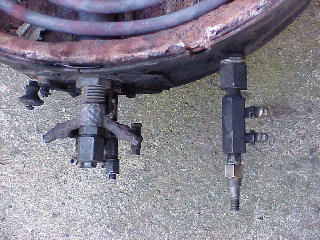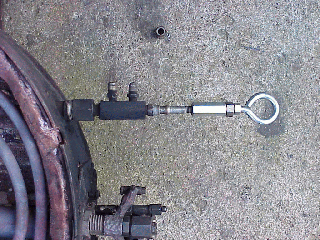
For Stanleys: a Modified Main Vaporizor Fitting
As built, condensing Stanleys had a cable inserted in the main vaporizor to improve gasifying the fuel and reduce "surging" in the burner. It also facilitated cleaning the vaporizor, if it was pulled and cleaned frequently. However, it was typically just a length of steel cable with the ends brazed to prevent unravelling. It could be pulled only by grabbing it with a pair of plyers, which, if the cable had been left too long, often had inadequate grip. Even worse, as the flow of fuel tended to carry the cable with it, it was possible for the end of the cable to disappear into the vaporizor pipe! (This has not happened to me, but I have seen it happen!) When this happened, cleaning the vaporizor became a serious problem.
To avoid this, I have made a different style of vaporizor inlet fitting, which restrains the cable and provides a good way to really pull it. This fitting consists of a piece of bar stock drilled and tapped to form a long pipe coupling. The size and material are not critical, mine is 2 1/4 inches of 7/8 hexagonal steel. Along one side of this bar two flare fittings are fitted, for fuel connections. This bar is screwed onto the end of the vaporizor and a 3/8 compression tube fitting screwed into the other end of the bar. One end of the cable is brazed into a piece of 3/8 diameter steel rod, the other end of which is threaded NC (3/8-16). The cable is then pushed through the compression fitting into the vaporizor until the 3/8 rod enters the fitting. Sliding on the compression bead and tightening the fitting nut completes the job.

Top View of Front of Burner
To pull the cable, take off the fitting nut, screw on a coupling nut and an eye bolt. You can really yank on this!

Ready to Pull
The reason for having two fuel connections to the vaporizor is so using the "firing up" valve feeds the burner directly. Most of the Stanleys had the valve connected through a length of tubing that normally contained kerosene, which limited the effectiveness of the valve.
By the way, it is good practice to have a check valve in the firing up line so if you leave the valve open (or it leaks) you won't fill the pilot tank with high pressure kerosene. A burst pilot tank would spoil your whole day, even if it did not catch fire!
Return to Steam Help
Last update: 12 December, 2000.